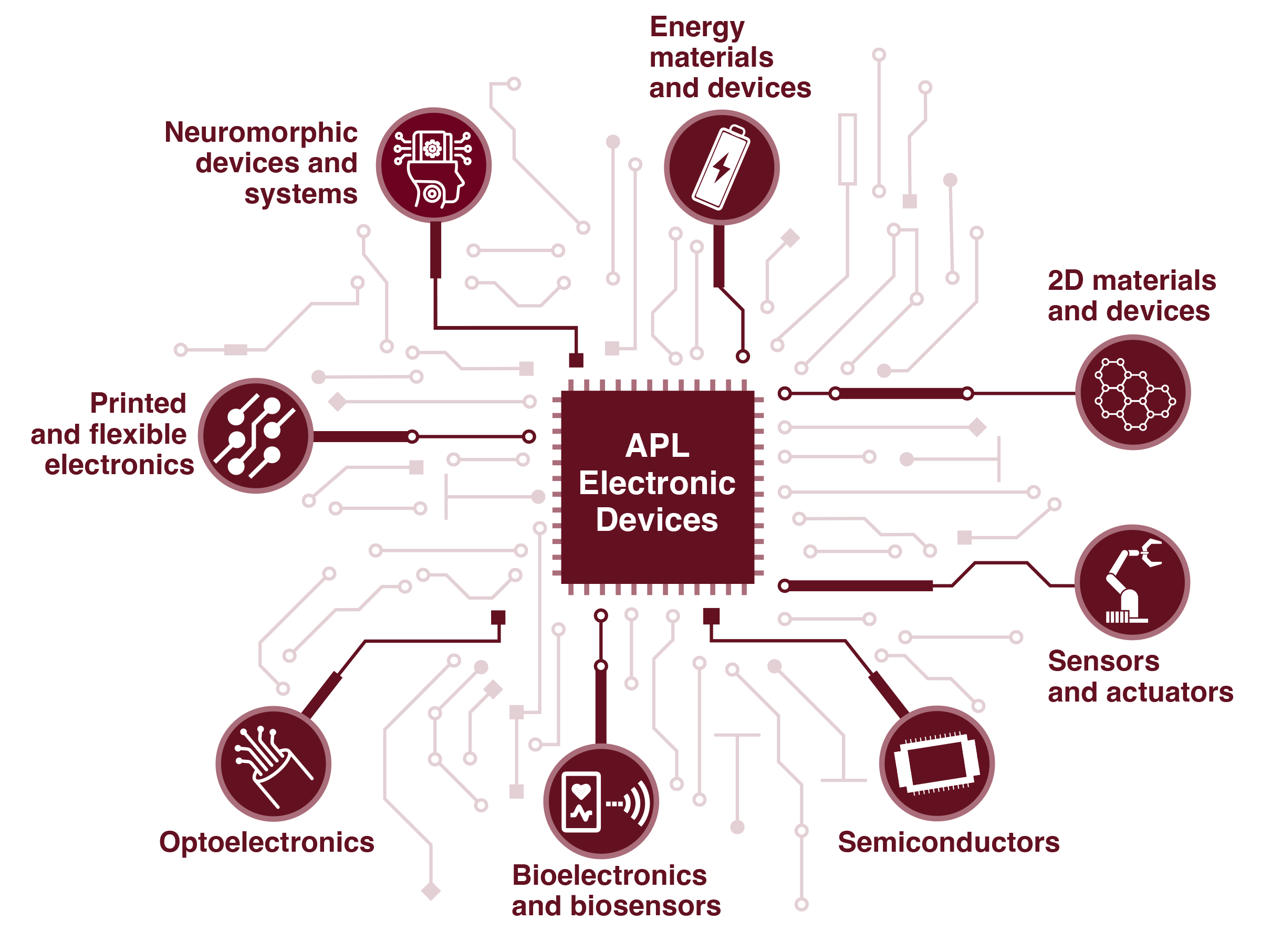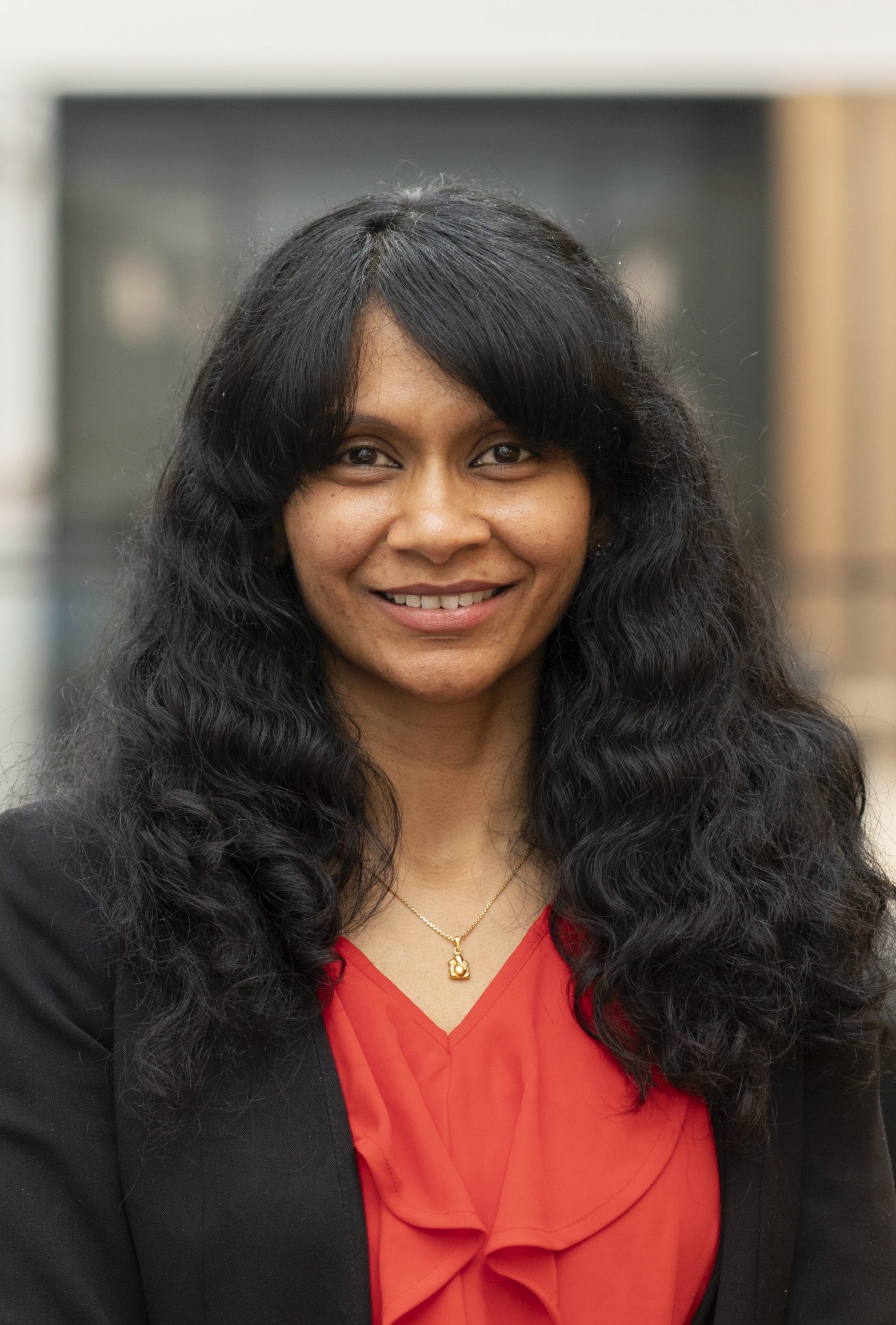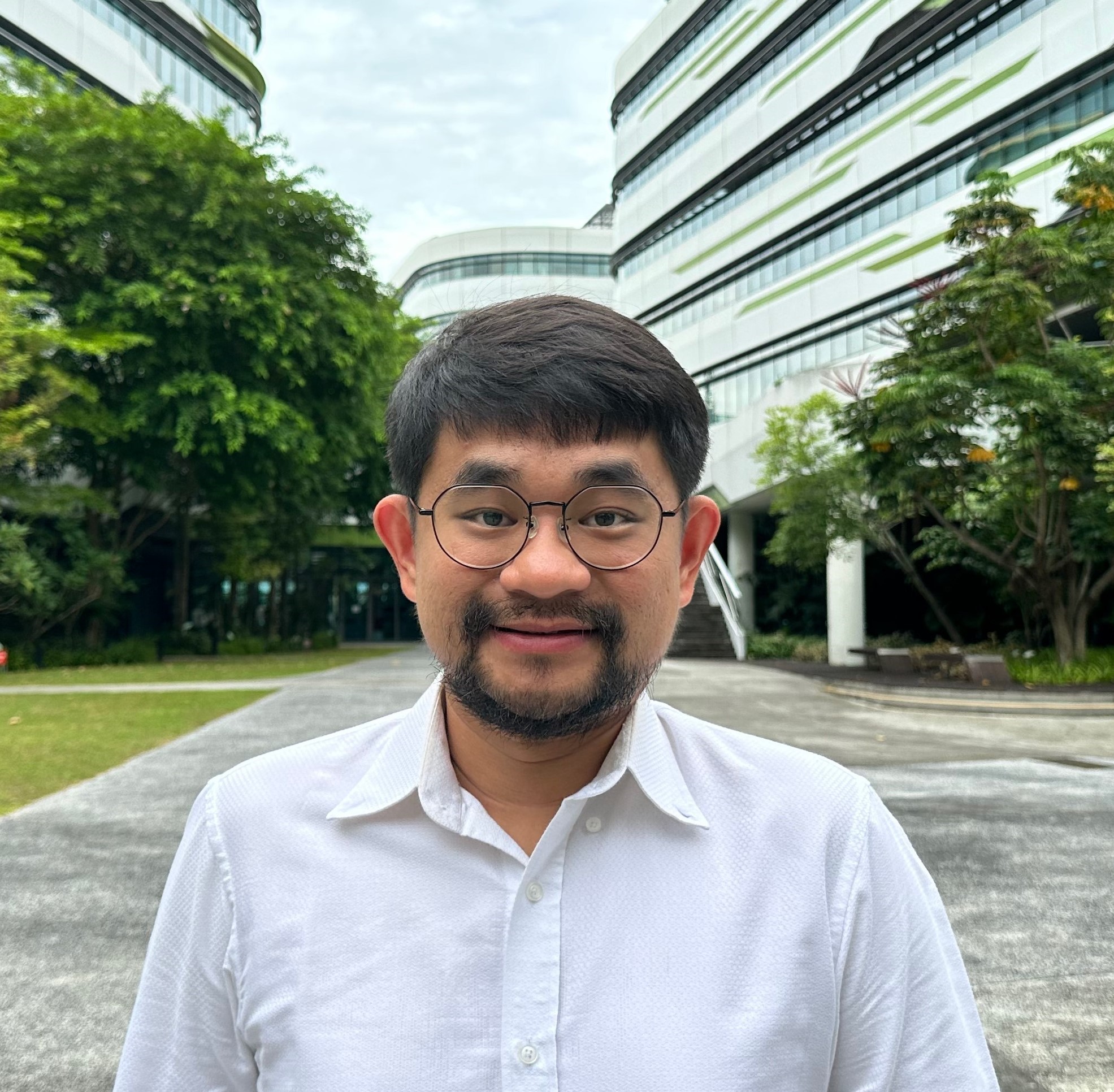APL Electronic Devices: Now Open for Submissions

Focus and Coverage | Editorial Policies | Format and Content | Preparing Your Manuscript | Data Availability and Reporting Standards | The Review Process | Open Access | Editorial Team | Editorial Advisory Board | Subscribe to our Newsletter
No Article Processing Charges (APCs) For Submissions Through December 31, 2025

Focus and Coverage
APL Electronic Devices publishes research related to the broad and interdisciplinary topic of electronic devices. As a journal that seeks to bridge multiple communities – theory/modeling, experimental/applied physics, and materials/engineering – we welcome contributions ranging from fundamental aspects of electronic structure to the design, fabrication, and characterization of real-world electronic devices. Capturing research that is interdisciplinary and/or translational, the journal brings together cross-cutting research themes across materials science and device engineering. The journal aims to foster interactions between academia and industry by highlighting emerging fields in electronic materials and devices.
APL Electronic Devices considers theoretical and experimental research that addresses topics including, but not limited to:
- Semiconductors
- Materials and devices for ICT
- Emerging semiconductors and heterostructures
- Power electronics
- Quantum devices
- Energy materials and devices
- Electrothermal and electromechanical systems
- Photovoltaic and photoelectrochemical systems
- Energy storage systems
- Bioelectronics and biosensors
- Epidermal and implantable electronics
- Electrochemical sensors
- Electroceuticals
- Optoelectronics
- Electronic and photonic devices including micro- and nanoelectronics
- Optical devices, sensors, and detectors
- Optical data storage
- Printed and flexible electronics
- Wearable electronics and smart textiles
- Additive manufacturing for microelectronics
- Functional inks for electronic devices
- Sensors and actuators
- Robotics
- Signal processing
- Human machine interfacing
- Neuromorphic devices and systems
- Memristors and non-volatile memories
- Neuromorphic computing
- Hardware for AI
- 2D materials and devices
- Structural and electronic properties of 2D device materials and heterostructures
- 2D semiconductor devices for future CMOS and integrated circuits
- Ultra low power devices and energy harvesters
- Emerging 2D device architectures
Editorial Policies
Criteria for Publication
APL Electronic Devices considers manuscripts for publication that meet the following criteria:
- Report research in theory, modeling, design, and applications of electronic devices.
- Contain novel and high-quality research that is of interest to the broad electronics research community and industry.
- Demonstrate results supported by rigorous data, methods, and analysis, with appropriate conclusions on device performance and reliability.
Format and Content
APL Electronic Devices will publish the following article types:
Articles contain novel and significant findings relevant to many researchers in the field. The timeliness, relevance of the research, and clarity of presentation are important factors that we consider when evaluating Article submissions. Articles should include sufficient experimental information to allow other researchers to reproduce the reported results. Authors may include supplementary material, including video or other multimedia files.
Reviews are succinct overviews that provide historical background and detail recent progress in topics covered by the journal’s scope. Reviews should be written in a way that enhances or introduces the work to researchers in the field.
Perspectives cover emerging topics or highlight a recent scientific discovery and/or industry direction. They provide a forward-looking discussion on the direction of a particular sub-field. Perspectives differ from Reviews in that they can present personal viewpoints from leaders in the field.
A Roadmap is a type of review article. These are by invitation only. This article type combines multiple sections, each written by different authors. The content of a Roadmap should focus on the status, advances, challenges, and future directions of subtopics within a field from multiple expert perspectives. As a united review, the Roadmap should provide a high-level overview of the field as a whole. Roadmaps should be composed when there is a need or opportunity for useful discussion and evaluation of the field. Authors who wish to submit a Roadmap without an invitation may provide a strong case for why their Roadmap is timely and of interest to the readership of the journal. Authors can download the pre-submission proposal form and submit the completed form to aplelectronics-journalmanager@aipjournals.org or directly contact the Journal Manager for further information.
Special Topic Issues are published occasionally and contain a grouping of Articles, Reviews, and/or Perspectives on a topic of current or emerging interest. These are intended to be reports of original research that significantly advance our understanding of the field. Editors review Special Topics using the usual publication criteria. Journal editors or Guest Editors may assemble a Special Topic.
Comments and Responses address scientific issues within articles published in the journal. Researchers considering a Comment are encouraged to directly contact the authors of the original article first, as comments will be published only if the same result cannot be achieved through publication of either an Erratum or a new article. We discourage Comments on questions of priority or calling attention to an oversight in a reference list.
Generally, the authors of the original article will be invited to submit a Response to the Comment, and the Comment and Response will be peer reviewed together. If the Comment and Response are both accepted, they will appear in the same journal issue.
No further exchange beyond this point will be considered for publication.
Comments and Responses should be no longer than roughly 1000 words.
Errata are corrections of errors in previously published papers. These may be errors introduced in the publication process by the author or the publisher, or errors in the research that were discovered after the paper was published. Errata should be confined to specific errors. Further discussion or additional work that either confirms or denies previous work should be presented as a separate Article or Comment.
Manuscript Length: There is no length limit in this journal; however, manuscripts should be concise and present a clear description of the research for reproducibility. As a guideline, the main text of an article should contain approximately 3500 words, excluding the title and references. For guidance on Perspectives, the main text should contain less than 5500 words. Reviews and Roadmaps are recommended to be up to 8000 words. In these papers, please insert section headings to structure the content and guide the reader.
Data Availability and Reporting Standards
AIP Publishing believes that science should be shared as widely as possible, and we actively support sustainable models of access to research that ensure the permanence, discoverability, and reuse of published work. All data, methods, and models should be well documented and described either in the main text of the article or supporting information to provide the research community with enough transparency and detail to effectively replicate the findings and reuse results to further their research.
APL Electronic Devices requires that authors make any new data publicly available on a repository of the author’s choosing at the time of submission. Any reasons that the material cannot be made available to the readers should be disclosed to the editors.
The Review Process
The Editor-in-Chief, aided by the Associate Editors, is responsible for the content and editorial matters related to APL Electronic Devices. To identify papers that meet the journal’s publication standards, the editors initially screen all submitted manuscripts. Manuscripts that pass the screening are evaluated by expert referees. Generally, two referees are sought, but decisions on publication may be made with additional reviews if required. Generally, we decide whether to publish a manuscript after one or two rounds of review. We will allow additional reviews if deemed necessary by the editors.
Language Standard
It is the authors’ responsibility to ensure that manuscripts are written clearly. A manuscript can be rejected if the scientific meaning is unclear due to poor English. Manuscripts that do not meet APL Electronic Devices’ language standard will be returned to the authors for rewrite before peer review, during the review process and/or if provisionally accepted pending language editing.
Because good science has no value unless it is clearly communicated, AIP Publishing recommends that authors use AIP Author Services to improve the quality of your paper’s written English. AIP Author Services was developed in line with our commitment to diversity, equity, and inclusion for all authors. Using this service ensures that your paper will be free of language deficiencies, so editors and reviewers will be able to fully understand your research during the review process. A native English-speaking subject matter expert of AIP Author Services will correct spelling, grammar and punctuation and verify the use and consistency of technical terms and content in your paper. Note that this is not a requirement or a guarantee of acceptance for review or publication.
Transfers
If your manuscript is not accepted for publication in APL Electronic Devices, an editor may recommend a transfer to another AIP Publishing journal for immediate consideration. In some cases, the transfers are offered after consultations with the editors of other AIP Publishing journals.
If you choose to transfer your manuscript, all reviewer reports and editor recommendations will be transferred along with the manuscript. Please visit the receiving journal’s website for more information. Manuscripts must meet the receiving journal’s acceptance criteria. Note that there is no guarantee that the receiving journal will publish a transferred manuscript. A list of AIP Publishing journals and descriptions can be found here.
The Appeals Process
Authors may appeal a decision to reject a manuscript. To submit an appeal, authors can visit the APL Electronic Devices submission site. To receive further consideration, the authors should request a formal appeal with justification for why the manuscript requires further consideration. If referee reports were included with the rejection letter, the comments must be addressed in the appeal request.
Once an appeal is submitted, the editors will collate all information relevant to the manuscript, including the cover letter, communications with the authors, and referee reports, if any. This information is discussed with the Editor-in-Chief, editors who worked on the manuscript, and any relevant Editorial Board members. When reviewing an appeal, any member of the Editorial Board with a real or perceived conflict of interest will not participate. The discussion will focus on the manuscript under consideration, the range of submissions the journal receives in the area, the overall status of the field, and the editors’ expectations for a paper in the area.
Successful appeals focus on clarifying the suitability or importance of the work if the editors rejected your manuscript because it did not fit APL Electronic Devices’ criteria for publication. If the editors rejected your manuscript based on technical issues, your appeal must rebut the technical issues raised in the referee’s reports. In your appeal, please address APL Electronic Devices’ acceptance standards. Also, keep in mind that because your manuscript was initially rejected, you must provide an insight or argument that goes beyond what the editor has already learned through the review process, thereby compelling the editor to conclude that your manuscript deserves further consideration.
Consider the following points when making an appeal:
- Do not include a simple revision of the manuscript to address referees’ comments. If a simple revision would have addressed the main issue, the editors would have returned your manuscript and allowed you to update it. Do include a strong argument for why the editors should reconsider your manuscript.
- Do not resubmit the manuscript under a new manuscript number, even if it has been updated in response to reviewers’ comments. The editorial office rejects resubmissions; instead, use the appeal process to request that the editors reconsider your manuscript.
- Do not reinterpret the referees’ reports for the editors. Do provide the editors with new information or insights that might lead them to reconsider publishing your manuscript.
- Do not provide a list of articles on the same topic that have recently been published in APL Electronic Devices. Do provide information that supports the novelty and importance of your work.
Retraction and Correction Policies
AIP Publishing’s policy is based on best practices in academic publishing. We take our responsibility to maintain the integrity and thoroughness of the scholarly record of our content seriously. We place great importance on the accuracy of published articles. Authors may make changes to articles after they have been published online only under the circumstances outlined in AIP Publishing’s Retraction and Correction Policies.
Open Access Statement
APL Electronic Devices is an open access journal. Articles published in APL Electronic Devices are freely accessible, without restrictions, to the global public. Authors who wish to publish in APL Electronic Devices retain the copyright to their work under a Creative Commons license. Under this license, users are free to share and adapt the material in any format, provided appropriate credit is given. Visit the AIP Publishing Open Access Policy for more information about our policies on open access.

Editorial Team

Editor-in-Chief
Sohini Kar-Narayan, FREng
Sohini Kar-Narayan is Professor of Device Materials in the Department of Materials Science at the University of Cambridge, where she leads an interdisciplinary research group working on functional nanomaterials and devices for energy, sensing, and biomedical applications. She received her PhD in Physics from the Indian Institute of Science, Bangalore, in 2009, and was awarded a prestigious Royal Society Dorothy Hodgkin Fellowship in 2012. She was the recipient of a World Economic Forum Young Scientist Award and a European Research Council (ERC) Starting Grant in 2015 and also an ERC Consolidator Grant in 2023. Prof. Kar-Narayan received the Royal Society of Chemistry Peter Day Prize in 2023 and was recognized as one of the Top 50 Women in Engineering of 2021 by the Women’s Engineering Society. She was elected Fellow of the Institute of Materials, Minerals & Mining (IoM3) in 2022, and Fellow of the Royal Academy of Engineering in 2024. She is also a Professorial Fellow of Clare Hall College in Cambridge. Prof. Kar-Narayan is a Co-Founder and Director of ArtioSense Ltd., a Cambridge University spin-out that seeks to commercialize microfluidic force sensors for precision orthopedic surgery, for which she was awarded the Armourers & Brasiers’ Venture Prize Award in 2022 and the Institute of Physics Lee Lucas Award in 2023. She was named “Innovator of the Year” at the 2024 Electronics Weekly Women Leaders in Electronics Awards and has been awarded the 2025 Royal Microscopical Society AFM and SPM Award.

Associate Editor
Yee Sin Ang
Dr. Yee Sin Ang is an Assistant Professor at the Singapore University of Technology and Design (SUTD). He is a computational physicist, currently leading a research group working on the device physics and the computational design of 2D semiconductors, interfaces and nanodevices for future sustainable computing electronics. His research interests cover first-principles simulations of 2D materials and contact interfaces, theory of carrier transport, interfacial charge injection modeling, and the computational design of novel device architecture such as sub-10-nm transistors, spintronics, valleytronics, and brain-inspired devices. Dr. Ang received his PhD from the University of Wollongong, Australia (2014). He is one of the Emerging Leaders of the Journal of Physics D: Applied Physics (Class of 2022). He is listed among the World’s Top 2% Scientists in the Applied Physics category by the Stanford University ranking in 2022 and 2023.

Associate Editor
Marko Tadjer
Dr. Marko Tadjer received a Ph.D. in Electrical Engineering from the University of Maryland, College Park in 2010, a Master of Science in Electrical Engineering from Duke University in 2004, and undergraduate degrees in Electrical and Computer Engineering from the University of Arkansas in 2002. He has completed postdoctoral fellowships at the Polytechnic University of Madrid in Spain in 2013 and at the High Power Electronics branch of the Naval Research Laboratory in 2015. In 2015, he became a Karles’ fellow at the Naval Research Laboratory, where he continues to work on III-Nitride, III-Oxide, and SiC power devices focuses on the integration of materials with attractive electrothermal properties such as novel p-type wide bandgap diamond and metal oxides. Dr. Tadjer has edited a book focused on thermal management of wide bandgap GaN electronics, authored or co-authored 9 book chapters and 300+ publications, including 20+ patents. He is a Senior Member of the IEEE.
Editorial Advisory Board
Early Career Editorial Advisory Board
The Early Career Editorial Advisory Board is comprised of emerging researchers who have completed their Ph.D. within the past 10 years (excluding career breaks such as maternity or paternity leave, adoption, eldercare etc.). Early Career Editorial Advisory Board members have all the same duties as the other Editorial Advisory Board members listed below. In addition, the early career members advise the Editors on matters of specific importance to early career researchers.
- Sebastian Bonilla (University of Oxford, UK)
- Buddha Boruah (University College London, UK)
- Yeonsik Choi (Yonsei University, South Korea)
- Saptarsi Ghosh (Swansea University, UK)
- Sreetosh Goswami (Indian Institute of Science Bangalore, India)
- Sarah Guerin (University of Limerick, Ireland)
- Shiying Guo (Yangzhou University, China)
- Jean Anne Incorvia (The University of Texas at Austin, USA)
- Qingshen Jing (University of Glasgow, Scotland)
- Hamideh Khanbareh (University of Bath, UK)
- Shi-Jun Liang (Nanjing University, China)
- James Spencer Lundh (US Naval Research Laboratory, USA)
- Tuhin Maity (IISER Thiruvananthapuram, India)
- Malavika Nair (University of Oxford, UK)
- Miriam Seiti (University of Brescia, Italy)
- Yan Wang (University of Cambridge, UK)
- Lishu Zhang (University of Nebraska-Lincoln, USA)
- Yi Zhou (National University of Singapore, Singapore)
Editorial Advisory Board
The Editorial Advisory Board is comprised of leading researchers in academia that advise the Editors on the journal’s scientific content and initiatives and on matters of editorial policy.
- Yang Bai (University of Oulu, Finland)
- Niladri Banerjee (Imperial College London, UK)
- Philippe Basset (Universite Gustave Eiffel, France)
- Ana Borras (Consejo Superior de Investigaciones Científicas, Spain)
- Annalisa Bruno (Nanyang Technological University, Singapore)
- Jun Chen (University of California, Los Angeles, USA)
- Judith Driscoll (University of Cambridge, UK)
- Arindam Ghosh (Indian Institute of Science Bangalore, India)
- Patrick Hopkins (University of Virginia, USA)
- Robert Hoye (University of Oxford, UK)
- Donata Iandolo (INSERM, France)
- Aruna Ivaturi (University of Strathclyde, Scotland)
- Swastik Kar (Northeastern University, USA)
- Miso Kim (Sungkyunkwan University, South Korea)
- Sang-Woo Kim (Yonsei University, South Korea)
- Rajesh Kumar (Indian Institute of Technology Indore, India)
- Shinbuhm Lee (Daegu Gyeongbuk Institute of Science and Technology, South Korea)
- Liang Li (Soochow University, China)
- Becky Peterson (University of Michigan, USA)
- Kin Leong Pey (Singapore University of Technology and Design, Singapore)
- Clarisse Ribeiro University of Minho, Portugal)
- Mathias Schubert (University of Nebraska-Lincoln)
- Urszula Stachewicz (AGH University of Krakow, Poland)
- Manish Tiwari (University College London, UK)
- Xudong Wang (University of Wisconsin-Madison, USA)
- Wenzhuo Wu (Purdue University, USA)
- Kaikai Xu (University of Electronic Science and Technology, China)
- Gang Zhang (Beijing Institute of Technology, China)
Industrial Advisory Board
The Industrial Advisory Board is comprised of leading experts and key opinion leaders that provide the Editors with valuable insight on the journal’s scientific content and initiatives and on matters of editorial policy from the point of view of industry. Industrial Advisory Board members help facilitate the exchange of ideas and opinions between academia and industry through the journal.
- Jehangir Cama (ArtioSense, UK)
- Takeki Itoh (Applied Materials, USA)
- Aga Iwasiewicz-Wabnig (Maxwell Centre Cambridge, UK)
- Yvonne Kavanagh (South East Technological University, Ireland)
- Adam Nightingale (Springboard, UK)
- Giles Sanders (TTP plc, UK)
Subscribe to our Newsletter
ISSN: 2995-8423 | CODEN: AEDPBN
